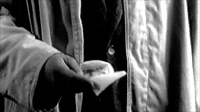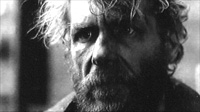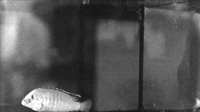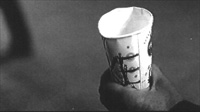|
Although Kleingeld is exemplary in a number of ways and could be used to illustrate a broad variety of narrative strategies perfectly suited to the short fiction film, four aspects of its storytelling stand out in particular. The first is Kleingeld's use of symbolic gesture, which might be defined as an act charged with meaning, and expressive of that meaning without the use of words. Although symbolic gestures occur throughout the film, and include for example the homeless man's washing of Hoffmann's car, its most dramatic occurrences are found in the final scene, where two symbolic gestures are coupled in an initiative/response figure:[1] Hoffmann, having found the homeless man he had nearly run over and from whom he had fled, offers a 100 mark bill to the beggar, who just looks him in the eye, then turns away. We understand perfectly that each of these symbolic gestures – the offer and refusal of the money – is charged with meaning for the characters engaged in this encounter, and that these final gestures also play a decisive role in defining the meaning of the story as a whole. But that meaning is left for us to explore and articulate as the film comes to an end, and that very activity of making sense of the story in our own thoughts when given significant gestures to interpret, helps to make the closure of Kleingeld particularly rich and satisfying to us, despite the fact that we are left with an unhappy ending. Especially in the short fiction film, where the essentials are almost always left unsaid, symbolic gestures are an ideal medium for the interaction of characters.
This brings us to a second aspect of the storytelling in Kleingeld: a perfect balance of character-focus and character-interaction. Character-focus refers to the clarity with which the film lets us know whose story is being told. In this case, we understand from the start that Kleingeld is Hoffmann's story. And knowing whose story it is helps us to find and keep our bearings throughout and to feel that the film remains centered and on course. At the same time, however, the story never lapses into static portraiture, but rather remains dynamic through character-interaction – above all, through Hoffmann's interaction with the homeless man, but also through his interactions with his colleague, his secretary and the man whose request for a loan he turns down. In Kleingeld, interaction keeps the film alive while we never lose sight of whose story is being told. This balance may not be necessary for good storytelling, but whenever it is present in a short fiction film, it greatly enriches our experience of the film. A third way in which Kleingeld tells its story is through objects identified with and expressive of the characters. Hoffmann is associated with the sterile perfection of hard, cold surfaces – the glass walls of his office, an aquarium unsullied by plants, his car's glossy finish and reflective windshield. His appearance and everything he touches is an embodiment of order, while everything about the unshaven and disheveled homeless man seems improvised, off-center, "unapproved," from his jiggling a bent wire into the slot of a metal box when we see him for the first time standing on a street corner as Hoffmann drives by, to the slightly wrinkled paper cup he clutches with the word danke scrawled on it. Given the economy with which a short fiction film must define its characters, the usefulness of enlisting objects in that process cannot be overestimated.
A fourth quality of Kleingeld is its focus on opportunities that can either be seized or missed. Stories in general, and short fiction films in particular, can invest in a given moment a set of opportunities that will come only once, and that the character whose story is being told can either make the most of or allow to slip by irretrievably. Kleingeld is the story of a missed opportunity, which Hoffmann cannot recover. The partnership he had accepted with the homeless man, even to the point of deliberately splashing his own car with mud in order to give the beggar something to wash away, is betrayed in a brief succession of thoughtless moments – trying to sneak away without being seen when he lacks a coin to drop in the paper cup, and driving away without a word after unintentionally knocking the beggar down in the parking lot. Stories can heighten our sense of opportunities inherent in the moment. Not all stories do this, nor would it be appropriate to suggest that all stories ought to do just this. But when a story focuses on such opportunities, as does Kleingeld, and evokes in us a sense of how easy it is to let them slip by, it not only plays out a narrative trajectory that holds our interest, but also serves as a reminder that can do no harm. | ||||||
1 This figure is described in some detail in p.o.v. no. 5 (March 1998), in my article: "Five parameters for story design in the short fiction film." | ||||||
|



